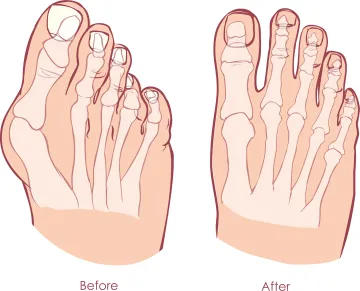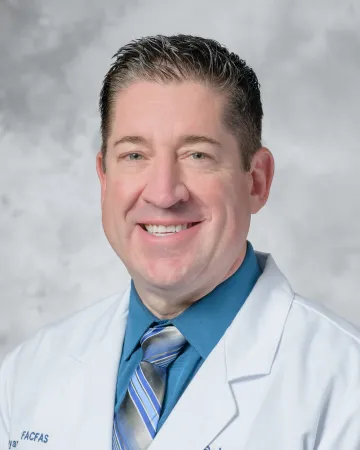Podiatry Services
Our team treats a wide range of foot and ankle issues and utilizes minimally invasive techniques to improve outcomes for patients by simplifying healing and reducing scarring.
Podiatric Care at the University of Arizona
Our podiatry team works closely with vascular and endovascular surgeons, orthopedic surgeons and other collaborators to bring patients individualized care to meet their needs.
We strive to address issues before they become limb-threatening, preserving mobility and preventing the cascade of morbidities that follow amputations.
Our podiatrists emphasize early intervention to treat conditions before they become more severe. Treatments can generally fall within the following categorizations: optimization, preservation, reconstruction, regeneration and limb salvage. Learn more about each area of treatment below.
Optimization of foot health focuses on maximizing the function of an overall healthy limb. For example, a patient's foot may function adequately, but the addition of an orthotic may provide additional support and correction that can reduce the risk of developing future conditions.
The goal of preservation is to maintain the level of function in a patient's foot. There may be some existing issues, but those can be managed through minimal interventions such as bigger shoes, pain management, fat pad injections and diabetic feet checks.
Reconstruction comes into play when someone has disfunctional extremities such as severe flat foot or severe charcot. Surgical reconstructive intervention can help address existing structural programs by realigning bones or tendons and fixing severe damage, with the goal of regaining function. Toe joins are one example of a reconstructive technique.
One of the only teams in the U.S. to specialize in podiatric regeneration, our providers utilize special devises called wound grafts, or artificial grafts, to recreate tissue and rebuild bone.
Through regeneration, providers can remove infected bone, preserve skin and soft tissue, and rebuild bone without harvesting large amounts from other parts of the body. This technique also helps prevent a cascade of morbidity by preventing wounds and injuries from developing elsewhere in the foot.
Regeneration is a less aggressive strategy to bring people back to their baseline while simultaneously avoiding significant deformations.
If previous tactics fail, our team will turn to limb salve, which still provides various options. Salvage is utilized when limbs are being threatened, and treatments are aimed at protecting limbs from full amputation while maintaining as much function as possible.
Limb salvage can be appropriate for treating conditions such as serious injuries, neuropathy (loss of sensation), and loss of blood flow or circulation to the feet. Our providers see patients who are navigating a wide range of situations, from side effects of chemotherapy or other medications to complications from diabetes or HIV.
Regardless of the cause, limb salvage is centered around functional amputations that allow people to continue walking and maintaining mobility.
Minimally Invasive and Robotic Surgery
Providing minimally invasive whenever possible is a high priority for the podiatry team at the University of Arizona. Minimally invasive and robotic surgery tend to result in less pain, smaller incisions, fewer infections and complications, less scarring. Our team members are early adopters of minimally invasive podiatry procedures nationally, integrating these techniques into patient care as needed, whenever possible.
Bunions: A Case Study in Podiatric Care
Around 1/3 of the U.S. population has a bunion, which is a boney bump on the outside of the big toe. Bunions form because years of pressure on the big toe causes deformity and pushes the joint out of alignment. Nonsurgical treatment options are available to manage bunions, but if those are unsuccessful, a bunionectomy may be performed to realign the bone and remove the bunion.
Depending on the severity of the bunion, different pathways of treatment can be utilized to achieve the desired goals.

Optimization or Preservation:
Perhaps you are experiencing a bunion for the first time and notice a bump with minor discomfort and irritation. Properly fitting shoes may be all that's needed to relieve pain and regain full, comfortable functionality.
Maybe you've had a bunion for a while and are taking pain medications to manage the discomfort. A doctor may recommend additional padding or inserts in the shoe, along with medications to reduce inflammation, to manage the condition.
Reconstruction and Regeneration:
If previous attempts to manage the condition are insufficient and the deformity is worsening, reconstruction may be suggested. Through reconstruction, your provider can reposition bones and manipulate tissues, often using minimally invasive techniques.
If a bunion is causing you severe pain, reconstruction tends to be the recommended treatment. A minimally invasive or open bunionectomy, a surgical procedure to reposition the big to into proper alignment, can reduce long-term pain and help you regain mobility.
Salvage:
In the most severe bunion cases, your podiatrist may recommend removing the damaged part of the joint. This surgery may weaken your ability to push off from the ground, but the tradeoff is that it will help you regain function and reduce pain long-term.
Meet our Providers
Make an Appointment
For the best surgical care in Tucson, Southern Arizona or the Southwest, make an appointment by calling
(520) 694-6690.
Contact Us
University of Arizona Department of Surgery
Division of Vascular and Endovascular Surgery
PO Box 245072
Tucson, AZ 85724-5072
Office Phone: (520) 626-6670





